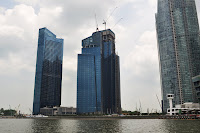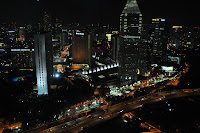The Singapore river divides it's host in two equally beautiful parts, the River Planning Area and the River Valley. Practically all land surrounding the river is commercial hot spot. Thus making the river cruise a perfect starting point for those who want to get a quick overview of Singapore.












Singapore by night
After a nice dinner at Clarkes Quay it was time for one last adventure before we'd call it a night.


The Singapore Flyer is the world's largest observation wheel, each rotation takes 30 minutes.
It was a real bitch getting there though cause the free brochure we found at the hotel said the closest subway station was City Hall but failed to mention that you then have to take a special shuttle bus. When we learned this we asked some guy who apparently was a complete idiot how long the bus ride was and he said we could easily walk it. Wrong! We did maybe half the distance but by then we had completely run out of curse words so we had to surrender and jump into a cab.
The hassle getting there turned out to be a blessing in disguise. Night time must be the perfect hour to take the ride actually. The land is dark and there's nothing but glittering city lights beneath your feet, it's urban beauty at it's best!
















